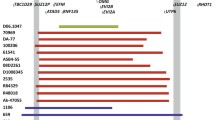Abstract
Mutations identified in the hypoxanthine phosphoribosyltransferase (HPRT) gene of patients with Lesch-Nyhan (LN) syndrome are dominated by simple base substitutions. Few hotspot positions have been identified, and only three large genomic rearrangements have been characterized at the molecular level. We have identified one novel mutation, two tentative hot spot mutations, and two deletions by direct sequencing of HPRT cDNA or genomic DNA from fibroblasts or T-lymphocytes from LN patients in five unrelated families. One is a missense mutation caused by a 610C→T transition of the first base of HPRT exon 9. This mutation has not been described previously in an LN patient. A nonsense mutation caused by a 508C→T transition at a CpG site in HPRT exon 7 in the second patient and his younger brother is the fifth mutation of this kind among LN patients. Another tentative hotspot mutation in the third patient, a frame shift caused by a G nucleotide insertion in a monotonous repeat of six Gs in HPRT exon 3, has been reported previously in three other LN patients. The fourth patient had a tandem deletion: a 57-bp deletion in an internally repeated Alu-sequence of intron 1 was separated by 14 bp from a 627-bp deletion that included HPRT exon 2 and was flanked by a 4-bp repeat. This complex mutation is probably caused by a combination of homologous recombination and replication slippage. Another large genomic deletion of 2969 bp in the fifth patient extended from one Alu-sequence in the promoter region to another Alu-sequence of intron 1, deleting the whole of HPRT exon 1. The breakpoints were located within two 39-bp homologous sequences, one of which overlapped with a well-conserved 26-bp Alu-core sequence previously suggested as promoting recombination. These results contribute to the establishment of a molecular spectrum of LN mutations, support previous data indicating possible mutational hotspots, and provide evidence for the involvement of Alu-mediated recombination in HPRT deletion mutagenesis.
Similar content being viewed by others
Author information
Authors and Affiliations
Additional information
Received: 21 April 1998 / Accepted: 16 July 1998
Rights and permissions
About this article
Cite this article
Tvrdik, T., Marcus, S., Hou, SM. et al. Molecular characterization of two deletion events involving Alu-sequences, one novel base substitution and two tentative hotspot mutations in the hypoxanthine phosphoribosyltransferase (HPRT) gene in five patients with Lesch-Nyhan syndrome. Hum Genet 103, 311–318 (1998). https://doi.org/10.1007/s004390050822
Published:
Issue Date:
DOI: https://doi.org/10.1007/s004390050822




